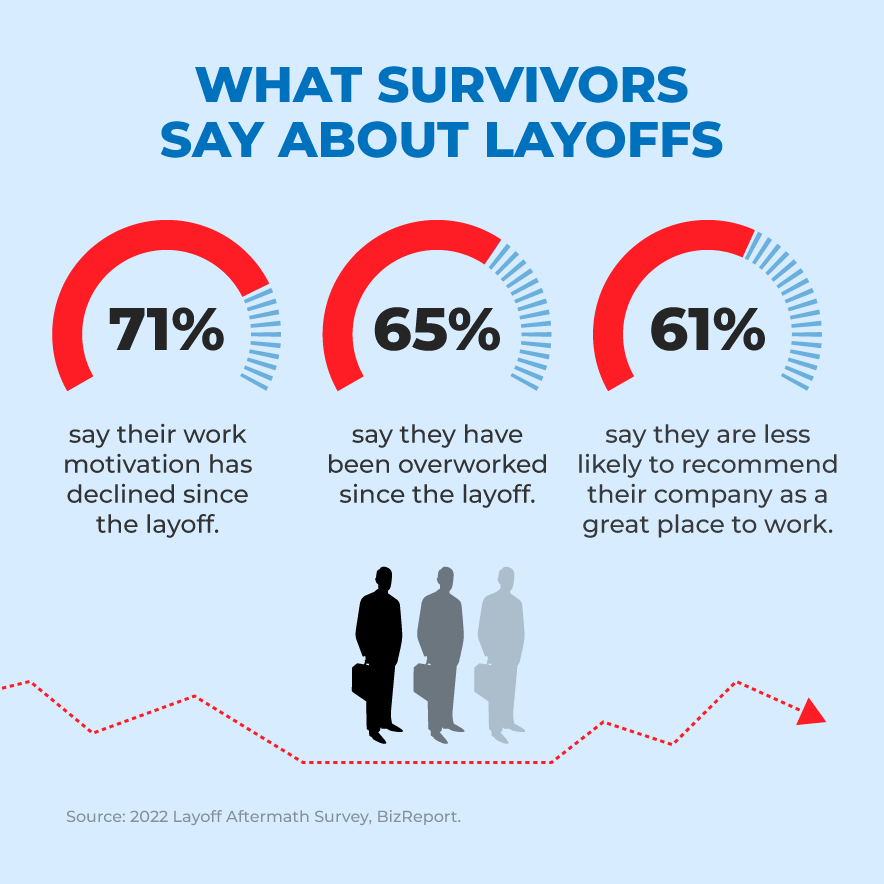How to Avoid Common Layoff Mistakes
Security Management has partnered with SHRM to bring you relevant articles on key workplace topics and strategies.
In the 2009 movie “Up in the Air,” a young HR executive shows her colleagues how to lay off a guy named “Ned” by video call. Ned’s firing isn't real; instead, the executive aims to show just how smoothly this difficult process can go.
“Hearing the words ‘You've been let go’ is never easy,” she tells Ned, assuring him that “anybody who ever built an empire or changed the world sat where you are right now.”
She promises Ned that “this is the first step of a process that will end with you in a new job that will fulfill you,” then directs him to gather his desk belongings and speak to no one as he leaves because “panic doesn't help anyone.”
To which Ned replies calmly, “I understand.” As if that ever really happens.
SponsoredNew risk, new solution. How to secure your technology and stay competitive.State-sponsored IP theft is on the rise. Read how Strider used open-source intelligence to identify the PRC’s plans to leapfrog competitors and advance its quantum technologies. |
Lack of planning. Lack of experience. Lack of training. Trite words of comfort. Making promises you can’t keep (like that “new job” that will fulfill Ned). These are among the mistakes that company leaders can make when planning and implementing a layoff. And in this era, when recession fears and inflation worries have spurred layoffs at many companies, how executives prepare for these firings will have consequences that reverberate among clients, customers, boards of directors, potential applicants, and workers who remain behind.
“The C-suite plays a significant role in handling layoffs properly,” says Amy Mosher, chief people officer at isolved, a software company based in Charlotte, North Carolina.
Mosher has conducted layoffs herself and advises executives on how to properly handle terminations. “In addition to ensuring that laying off employees is the best course of action, they play a critical part in maintaining business continuity and confidence after the fact,” she says.
Consider Alternatives
Too often, corporate leaders rush to layoffs to alleviate financial pressures.
“Laying people off should not be the first thought that comes to your mind,” says Phyllis G. Hartman, SHRM-SCP, president of Pittsburgh, Pennsylvania-based PGHR Consulting and an advisor for executives planning terminations. “What I bring up [to leaders] is ‘Look, if we do this, it’s not without issues. So, if we do it, let’s be sure we’ve explored all the options and make sure we do it right, because if you don’t do it right, there can be fallout.’”
Geoff Colvin, Fortune’s senior editor-at-large and author of several books, recently wrote that mass layoffs typically come with “hidden costs” beyond the immediate price of severance pay and benefits for departing workers. Those include a loss of organizational knowledge, a disruption to processes, and lowered productivity and morale among the remaining employees, according to researchers.
“Layoffs are alluring in difficult times and when the next quarter’s earnings are in peril. But that may be the short-termism trap,” Colvin wrote. “As more CEOs consider downsizing their workforce, it would behoove them to question whether, in the big picture, the long-term case against layoffs is more persuasive.”
If financial pressures do point to eventual layoffs, then executives need to set an example well before they start letting people go, says John W. Mitchell, president and CEO of the electronics industry trade group IPC International and author of the upcoming book Fire Your Hiring Habits: Building an Environment that Attracts Top Talent in Today's Workforce.
“When you need to manage costs, the first step is for the executive team to take pay cuts,” Mitchell says. “This should be done months ahead of the necessity of a reduction in force and shared with the full organization, so employees understand everyone from the top down has skin in the game.”
Moreover, he says, the CEO—long before layoffs are at the door—should announce to workers that job cuts may be on the table. Good leaders should be astute enough about their company’s finances and future prospects to know if and when that may have to be an option, Mitchell notes. Assuring workers that their jobs are safe may be tempting if leaders fear losing talent, but making promises they know they can’t keep only undermines the C-suite’s credibility.
Make Precision Cuts
Typically, identifying which employees must go starts at the leadership level, often with the help of HR and legal counsel. It’s at this level, Mosher says, that executives can avoid mistakes that might lead to embarrassing and costly lawsuits.
First, they should examine the business at a tactical level. What is the cost per employee compared to the revenue generated by that employee? Do employees who remain have what they need to produce for the business?
“Mistakes can be made when the wrong people or roles are restructured or let go and when the financial implications are not in alignment with the business’s goals,” Mosher says.
One rule of thumb that companies have historically used during layoffs is “last in, first out,” meaning that the newest employees are the first to go, regardless of performance. But this can be a mistake, says George Morrison, an attorney with Buchanan Ingersoll Rooney in Philadelphia, Pennsylvania.
“Cutting whoever was last in is not that simple. You have to analyze if that will have a disparate impact on a particular protected category” of workers, Morrison says. “And performance is not that easy to get your hands around. Depending on the time of year and when performance reviews are conducted, [leaders] may not have access to good information as to what current employees' performance is.”
Hartman notes that when leaders eliminate people in protected classes, even without realizing it, “you’re setting yourself up for a complaint, and it’s very easy today for someone to Google ‘How do I file a complaint?’ All the details and directions are there.”
Communication Pitfalls
When layoffs are unavoidable, communicating about them in as transparent and humane a manner as possible often requires training—even for the C-suite. Subterfuge and mixed messages are not options.
Hartman recalls that at one company years ago, a new leader had employees from across the nation come into headquarters for a corporatewide meeting, where the CEO discussed the organization’s vision and how it would move into the future. Afterward, several employees were called into one-on-ones with HR and let go.
“That’s bad,” Hartman said. “You’re inviting people to come into this rah-rah meeting about the future and then telling them, ‘But you’re not coming with us.’ To me, that came across as mean, and I know some people who are still angry about it. That’s a poor demonstration of empathy.”

Stacey Berk, founder and managing consultant at Expand HR Consulting based in Rockville, Maryland, advises boards and executives on reductions in force (RIFs). She has seen many organizations manage layoffs well, but when they are mishandled, “it is usually because the CEO gets in their own way.”
“They are afraid of making the wrong decisions, not analyzing the right data, and they are not anticipating the impact or fallout,” she says. “Sometimes they are just poor leaders. Other times it is indeed a true lack of compassion for others.”
Berk recalls a large technology company that, before notifying those workers who would be let go, disabled their Slack access, e-mail, and other internal communications some eight hours before the employees learned of their firings.
“It was chaotic, and the process lacked empathy for people losing their jobs,” she says. “In large companies, when RIFs or layoffs are planned, [leaders] often look past standard best practices of informing employees in person. Sometimes this is due to the ratio of employees to HR representatives, but other times it’s just not a priority.”
During Twitter’s widespread layoffs in November, fired employees learned they would no longer work for the social media platform via a robotic-type internal memo.
Elsewhere, nearly 2,700 workers at Mississippi-based United Furniture Industries learned of the same fate from a company text while most of them slept—just before midnight on 21 November, days before Thanksgiving.
Hartman suspects this approach to layoffs happens for one of several reasons, all of which might be addressed through training. Maybe the leader believes that because most people are accustomed to e-mail or texting, it’s OK to communicate a firing this way. Or, she says, it might be that the leader is uncomfortable delivering, or having underlings deliver, bad news. Or it could simply be that the leader is new or inexperienced.
“It all has to do with how people have learned how to communicate,” she says. “I know a lot of [leaders] who’ve retired in recent years, and it left a hole in leadership experience.”
Their replacements may not have enough experience to understand why someone shouldn’t send a text when firing an employee. They might also fear that employees will become violent, or they just don't want to deal with workers’ emotions.
“As a leader, you need to have well-developed skills in delivering good news and bad news,” Hartman says.
Person to Person
Delivering such sobering news should always be done in a conversation, Hartman says, even if it’s over Zoom or another video-type format.
And when such bad news is delivered, she says, it behooves leaders to think beyond the obvious offerings, such as providing the fired worker with information on how to access unemployment, financial resources, and job search assistance; how long their benefits will last; and how to communicate with the company’s employee assistance program.
At one company where Hartman worked, the executives first contacted organizations that might need their fired workers’ talents and then provided a list of those organizations to the people who were let go.
Hartman has also worked with companies that had to lay off high-level employees who likely hadn’t looked for a job in years. Those companies hired a contractor to provide these employees with outplacement counseling.
One key thing U.S. company leaders must consider is the Worker Adjustment and Retraining Notification (WARN) Act, which protects workers from the impacts of unexpected loss of employment by requiring employers to give sufficient notice to employees.
Regrettably, Morrison says, a lot of executives forget—or simply don’t know—that they need to comply with the law.
"For most decision-makers, it's a very stressful time, and they may not be focused on the legal restrictions under WARN," he says. "The penalties [for noncompliance] are substantial."
The Fallout
Finally, company leaders may be under so much pressure to fix their bottom line that they fail to take the long view when handling terminations, overlooking the repercussions for clients, consumers, boards of directors, future applicants, and remaining employees.
“Some of the risks may be that employees sour on the organization and look for a reason to sue,” Berk says. “Or they give poor employer ratings on websites such as Glassdoor. Or the company reaches out to rehire, and [fired workers] won’t return the call. For employees who are retained, it can create an environment of fear and instability.”
Hartman says those still on the job are left wondering, “Now I have to do more work. Am I next? Will they get rid of all of us? Why are they doing this?”
In addition, lawsuits filed by fired employees may have a lasting impact on the organization’s reputation.
“Employees who are gone will talk, and those left behind will talk and it will get out,” Hartman says. “A lot of people today don’t want to do business with organizations that they don't think are fair or equitable.”
She agrees with them. “I myself won’t do business with one company because I’ve read about how they laid people off. I just don’t patronize them,” she says.
In the end, treating people with empathy and compassion doesn’t cost the company anything financially, Mosher says, “but it has a huge impact on the well-being of your culture and employee base left behind and their ability to move forward quickly and efficiently.”
Dana Wilkie is a freelance writer based in Ormond Beach, Florida.














